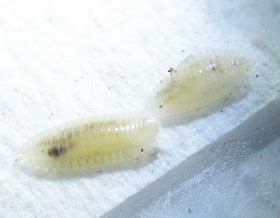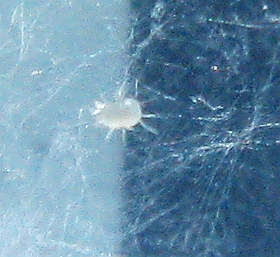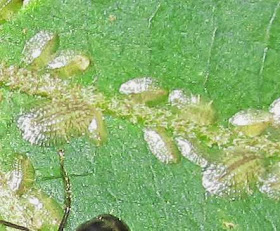Commensalism, mutualism, parasitism and other associations.
Wingless Wasps.
A female wasp of the type found in figs. Only the female of such wasp are wingless.
A velvet ant or cow killer. Velvet ants are solitary wasps which are usually parasitic of other wasps. Velvet ants often pack a very painful sting. Only females are wingless.
Parasitoids.
A parasitic eucharitid wasp of Nylanderia ants. Ant parasitoids usually lay their eggs in the larvae or pupae of ants. Some parasitic flies lay their eggs on or in the adult ants.
A parasitic eucharitid wasp of Nylanderia ants.
A parasitic eucharitid wasp of Nylanderia ants.
A parasitic eucharitid wasp of Diacamma's pupa. This wasp also parasites on Camponotus ants.
A parasitic eucharitid wasp of Diacamma's and Camponotus pupae.
Parasitism.
Parasitic nematode worm of Ponerinae ants
Parasitic nematode worm of Ponerinae ants.
Mites clinging on to pupa of Tetramorium.
Roughly 2 tenth of a millimeter this mite is parasitic of the brood of ants and also their food hoard.
A parasitic mite of ants.
The parasitic mite clinging to a Polyhachis male alate.
Parasitic mites of ant's brood. These mites are similar in nature to those turtle mites reported to have seriously impacted commercial bees colonies.
Mites clinging on to a Gnamptogenys ant
A mite inside the pupa cocoon of a Camponotus irritans major worker.
Close up of the mite (enhanced below).
How the mite looks like outside of the cocoon. This one was inside the cocoon of a Diacamma pupa.
Parasitic mite of Paratrechina longicornis (and also Pheidole) pupae.
This similar mite is found on the pupa of a Pheidole major worker. It is approximately 20 percent larger than those found on Paratrechina longicornis.
The mites only feeds on the pupae, attaching to the top of the gaster.
Once latched on the mites will suck dry the pupae leaving an empty shell (left both top and bottom photo)
Termitophiles
This millipede is commonly found in termites nest as in this case of that of
Dicuspiditermes nemorosus where they feeds mostly on the termites nutrient rich 'droppings'. In most species of humus feeding termites, the adults' droppings are food for nymphs or larvae. Without careful observation this millipede may appear as some sow bug or silverfish that also inhabit a similar habitat.
Millipedes that are symbiotes of termites.
Millipedes that are symbiotes of termites.
Millipedes that are symbiotes of termites.
The millipedes turned turtle showing the well protected and hidden legs.
This parasitic Rove beetle is found in Macrotermes gilvus nests.
Commensalism.
Commensalistic relationship defines inter species relationship where neither species particularly suffers harm from the relationship. But in the case of ants and termites the other species in these commensalistic relationships usually derive some benefits and are mostly free loaders.
Mites
A large commensalistic mite on the larva of Pheidologeton. This is a 'thief' mite that feeds on the food of ants either directly on the prey or sharing the scraps of food fed to larvae. Some mites also feed on the brood of ants. Many species of mites (among other arthropods) are either tolerated by ants and termites or somehow not detected by the ants and termites. It is not clear if the ants or termites derive any benefit from these brazen thieves who have unchecked access to their food and nest.
The common ant and termite mite. This tiny commensalistic Australhypopus mite clings to ants and termites. Even though when few in numbers as is often found in natural in-the-wild situations this mite do not pose a problem to ant and termite colonies, however infestation of this mite in kept colonies can be very serious.
A tenacious Australhypopus mites clinging onto a termite worker.
Another tenacious mites clinging onto a minor worker of Macrotermes gilvus. This species of mites are half the size of the Australlypopus mites in the photo above this.
Extremely slow moving they stayed on the termite even after it has died.
They are also translucent and being very tiny almost transparent (and very difficult to see and shoot when not on the host), circled are three that had dropped off but barely moving. That was the best my cheap camera can do so I improvised with a droplet of water (see below) that makes the mites easier to see in the image.
Here with the aid of a tiny water droplet are seen four tiny mites.
Another species (and genus) of clinging (or what I called commuter) mites seen here clinging to a Tetramorium queen. This species is slightly more mobile moving at around half the speed of dustmites.
Smaller than the first species (and genus) of clinging mites but larger than the second.
A turtle mite clinging onto a termite worker.
The mite on its back showing the legs. While having a 'turtled' shape back protects the mite from being dislodged or eaten, when it falls on its back (something that almost never happen in the wild) it has no means to right itself up unaided.
A turtle mite clinging onto a termite worker.
A turtle mite clinging onto a termite soldier.
A turtle mite clinging onto a termite soldier.
Australhypopus mites clinging onto a Solenopsis ant worker. Australlhypopus mites infest both ants and termites. Australhypopus mites are sensitive to low humidity and in dry conditions will die within several hours. They can go for long period without food. Being very slow moving they make use of other arthropods as transport to get to food sources where they feasts and also lay eggs. In this manner they are spread in the wild. But in kept colonies with no dispersal they accumulate very quickly and the entire colony will be covered from head to foot within a matter of weeks.
These mites mainly feed on the food the ants bring back to their nest or follow the ants out to feed on their food find as in the case in the photo above showing a group of them feeding on a morsel of chicken meat and probably also laying their eggs after dropping off from the ants.
In the wild infestation by these mites are rarely serious but in kept nest, they can overwhelm the nest by the sheer numbers covering the individuals in the colony almost completely. Photo above is the lid of a container in which I place a few of these mites, a small damp piece of tissue and a pinch of cooked chicken meat every day. In a matter of a less than a month the entire container is crowded with these mites. Removal from kept colony is a simple (but not easy) process of poisoning with poison laced food. The process may take a few months in serious infestation of a large colony. Alternative to poisoning is tedious but can be successfully carried out with some diligence.
Australhypopus Mites Irradication From Kept Colonies
They are simple to remove but not necessarily easy as eradication has to be thorough and complete leaving not even a single mite otherwise within weeks you will be back to full infestation.
These mites are commensalistic and not parasitic. They basically feed and lay their eggs on the food the ants brought back into their nest. Two methods can be employed (a third may be harder to implement for subterranean ants).
The first is of course poison baiting but this method require that the baited food must not be accessible to the ants so more practical for larger ants.
The second is to remove all food from the colony that is uneaten after a few hours. This method is more tedious and requires more frequent feeding of the ants plus clearing off all uneaten food within a few hours. This method may also slow down brood and colony growth but that is not critical.
With Pheidologeton removal is especially difficult as removing uneaten food is not easy and reducing humidity (the third method as these mites die out when it is dry aka low humidity) may crash the colony.
In all methods the implementation will need to be kept up for a few months to ensure not a single mite remains before you can resume normal rearing (feeding) cycle.
Other Mites
Tiny commensalistic turtle mites. These are commonly found in the nest of large ants such as
Diacamma.
Diacamma nests typically have numerous species of commensalistic arthropods. Diacamma are commonly host to a large number of commensalistic arthropods from mites, sow bugs, Collembola, tiny beetles to millipedes.
Collembola
A Collembola or springtail. This is one of the most common commensalistic partner of ants and termites. Some species of ants such as Strumigenys, Anochetus and Myrmoteras are specialist predator of Collembola. Some small to tiny species of Brachyponera ants are also specialist hunters of Collembola. Many small and tiny ants not able to catch them also scavenge on their eggs as well as their dead (those dying naturally).
Collembola.
Springtails or Collembola.
Springtails.
Springtails or Collembola.
Banded springtail or Collembola are commonly found under the bark of trees. These are generally not as prolific as other Collembola species.
Banded springtail or Collembola appeared to be equipped with eyes
Banded springtail or Collembola
Springtails aka Collembola harvesting. These prolific insects are ideal live food cultures to feed small aquarium fishes such as guppies, betas and neon tetras as well as fries of fishes, shrimps and crabs as well their larvae. They are also ideal live food for small insects and other arthropods or their larvae or nymphs.
The Ubiquitous dustmite.
This is how a typical dustmite looks like to the naked human eye.
On closer examination (not microscorpic view) you can see the head and legs.
While dustmites are not found with either ants or termites in the wild. They do find their way into the nest of 'domesticated' species in kept nest.
The size of the common dustmite measured against a millimiter tape.
Dustmites and a springtail
Tiny Cockroach Related Insect
A delicate species of small insect that looks like small 'cockroaches' found living among some species of termites. They are small and unless examined closely might be mistaken for sow bugs. They are as delicate as the termites they are found with. Association is probably commensalism.
Of interest is their beaded antennae and their relatively large eggs.
A species of small delicate cockroach-like insect that may be mistaken as Nicoletiid silverfish except that these are relatively slow moving.
A species of small delicate cockroach-like insect. The imago (yellowish color) and the nymphal stage.
The adult form of these commensalistic 'cockroaches' are wingless. Above photo shows two adults (golden color very similar to the nicoledid silverfish in the photo below) besides a larva or nymph (left) of these 'cockroaches'.
Nicoletiidae silverfish
A myrmecophilous nicoletiidae silverfish this species is a common symbiotes of termites and ants.
The Nicoletiidae silverfish (Thysanura).
Another species of Nicoletiidae silverfish that too is a symbiotes of termites and ants.
Here is another species of Nicoletiidae silverfish that too is a symbiotes of termites and ants.
A more regular looking Nicoledtiidae silver fish.
The common silver fish found in human's habitations.
Crickets
Crickets commonly found among ants colonies and nests. These so called ants loving crickets are commonly found living as nest mates among crazy ants and are accepted by the ants. The smaller with Paratrechina longicornis while the larger with Anoplolepis gracilipes. Photo below showing the smaller of these crickets hiding under Paratrechina longicornis for safety. See more in post
Those Crazy Ants.
Another species of ants loving cricket, this one in a Camponotus arrogans nest.
Sow bugs
A sow bug. Sow bugs are Isopods. This species is commonly found in the nests of termites living in excrement typed nest.
Sow bug
A sow bug. Sow bugs are Isopods. This species is commonly found in the nests of termites living in excrement typed nest.
Detritus feeding white nematode worm. This worm feeds on mold and cottony fungus and their mycelium.
Mutualism.

Oecophylla smaragdina workers collecting the sweet secretions of this leaf eating caterpillar of Hypolycaena erylus. This is a mutualistic relationship. The caterpillar gets protection from predators and reward the ants for the protection with a sweet sugary secretion. The caterpillar would have a tough time surviving in a tree without an Oecophylla colony.
Hypolycaena erylus butterfly

Coreid bug. These are sap suckers and are 'milked' by ants for the honeydew they secrete.
This coreid bug has just recently molted.
A species of small shield bug that lives under loose tree barks that Camponotus ants tend and protect for honeydew secretions.
Camponotus arrogans ants tending and protect their sugar 'cows'.
Aphids in mutualistic relationship with Acropyga ants.
Aphids in mutualistic relationship with Acropyga ants. Acropyga ants tending the aphids inside their nest.
Aphids in mutualistic relationship with Acropyga ants shown against a millimeter measure.
Camponotus ant workers tending hoppers for honeydew. Here also is a butterfly that specialized in feeding on honeydew from hoppers.
Yellow crazy ant workers tending hoppers for honeydew. Same butterfly species that specialized in feeding on honeydew from hoppers also feeding with the crazy ants.
Camponotus ants sheltering aphids that they tend for honeydew.
Dolichoderus ants tending aphids and hoppers.
Dolichoderus ants tending aphids.
Dolichoderus ants tending mealy bugs.
Dolichoderus ants tending scale insects.
Camponotus ants 'milking' scale insect for honey dew.
Scales insects are immobile. Once they latch on to a leaf or stem they ceased to be mobile.
Scale insect sucking sap from a leaf.
Scale insect upside down.
Scale insect inverted (turned turtle) showing the larvae.
Scale insects, adults and larvae.
Adult scale insect are immobile, the larvae however are not.
Scale insects (both the winged and non winged) tended by Monomorium floricola ants. These particular species of scale insects feed on long blade grass species including sugar cane.
Winged imago (adult scale insect) laying eggs (eggs seen on both sides winged imago) in almost a constant stream as she feeds sucking out plant sap.
Very quickly the horde spread
And the blade become covered with scale insects and within months the whole plant. They tend to target plants that are more shaded from the hot noon day sun, or the more shaded leaves blade.
Not sure what this sap sucking insect is but it is tended by Pseudolasius ants.
Not sure what this sap sucking insect larva is but it is tended by Pseudolasius ants.
Last Updated: 2021 09 03
First Posted: 2011 05 18
© 2009 – 2021 Quah. All rights reserved.
























































































































Nice! You should keep an eye out for Schizomids, scorpions and assassin bugs in your quests for termites. Heard they can be found in termite nests. Pics and info on them would be a great addition to your site.
ReplyDeleteThese are found around nests of ants and termites but not commonly in the nests as they are generally not tolerate by both ants or termites.
ReplyDeleteFor Schizomids, scorpions and assassin bugs see page http://termitesandants.blogspot.com/2011/05/other-stuff-relevant-and-irrelevant.html
ReplyDelete